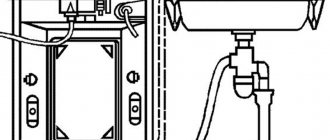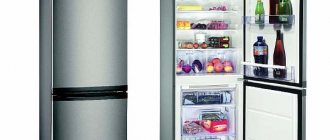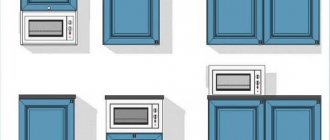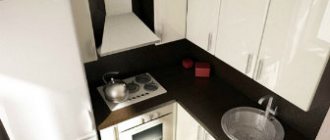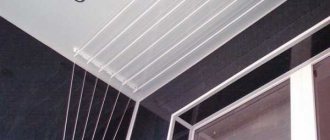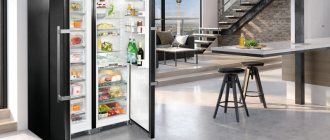Installing a refrigerator on the balcony makes the kitchen more spacious, but there are some restrictions on the use of such household appliances in unheated rooms. In this case, it does not matter at all what brand of product is used; almost all models of such devices are not allowed to be used at sub-zero temperatures. The reasons for this ban, as well as how to correctly resolve the issue of placing a refrigeration unit in winter, will be discussed in detail in this article.
Professional opinion and instructions
One of the primary characteristics of the unit is the climate class, which indicates the ambient temperature in which the refrigerator operates normally and is guaranteed to last for a long time. Manufacturers of household appliances recommend sticking to a “plug” of 16-32 degrees (class N - normal). Some samples can perform their functions over a wider temperature range from 10 to 43 degrees - the so-called universal class, marked SN-T.
Failure to follow the recommendations can cause unstable operation of the refrigerator and even a breakdown that is not covered by warranty service - this means that you will have to repair it out of your own pocket. If your balcony is not equipped with a battery, then even when it is glazed, sending a refrigerator there is allowed only at a temperature of at least 11 degrees.
Our climate suggests a significant decrease in the established value in winter and during the demi-season. In some regions, summer weather is characterized by an indicator above 40 on the thermometer, so the only option may be to temporarily install the unit on the loggia during moderately warm times, and then move it back to the living rooms during the period of cold and heat. Agree, it is very difficult to constantly drag and drop equipment. It is not surprising that some owners ignore this rule and thereby significantly worsen the performance characteristics of the refrigerator.
Professional opinion and instructions
Organizing a cellar on the balcony with your own hands
Such a cellar, as a rule, is a stationary, insulated box of dimensions specified by the master, in which a slightly positive temperature is artificially maintained (only heating is carried out when the temperature on the balcony drops to 0 or below) from autumn to spring.
Let's consider how to make a cellar of this type on the balcony:
- The inner box of the container is constructed from boards, slats and beams, after pre-impregnating the wooden materials with machine oil to avoid rotting. Diesel fuel can also be used.
- The walls of the box are lined with polystyrene foam boards. The final thickness of the insulation of the balcony box should be 5-10 cm, depending on the climate. It is better to use slabs in 2 layers and lay them staggered to avoid heat leakage through the joints.
- In the corners and at the joints the insulation is sealed with polyurethane foam.
- A door is made and adjusted to the dimensions and configuration of the container opening so that the side edges of the door are beveled for a density of 3 cm per 10 cm thickness. The door is insulated with mineral wool and covered with moisture-resistant plywood on top. The lid is installed with an overlap for more convenient gripping and lifting.
- The lid is secured to the box using metal hinges.
- The bottom of the box is made in the same way as the walls - from boards and insulation for the balcony. after which it is connected to the common frame.
- On top of the insulation, all outer planes of the cellar are also finished with wooden material, which serves as an additional means of insulation from moisture and cold and at the same time gives the structure a normal appearance.
- At the bottom inside the cellar there is a socket with a 75-watt light bulb, which, in fact, will serve as a means of heating, maintaining the temperature in the container above zero. A protective casing is arranged for it so that the light does not scatter inside the container and to avoid accidental damage to the lamp. The cartridge is “powered” from a regular outlet.
This method requires personal monitoring of the temperature on the balcony and manually turning on the lamp if necessary. If desired, you can organize automatic control of the temperature and on/off the light bulb by installing a temperature sensor with a relay system in the cellar, but this will slightly increase the cost of the design.
On a note! It is better to place vegetables inside the container in boxes, such as plastic ones for apples. This will ensure normal air circulation and uniform temperature distribution in the box.
What to consider when choosing cellar ventilation methods
Usually the cellar on the balcony is not used for one thing. Housewives, in addition to agricultural products, hide flower bulbs, canned food, and dried fruits there. This set requires different storage conditions. Then the space inside the cellar is divided into zones, selecting a special air circulation mode for each.
Vegetables and fruits, like all living things, breathe. Apples adjacent to potatoes will absorb the potato smell. The whole house will smell like onions if you don’t use forced ventilation.
To do this, one end of a long plastic pipe is inserted into the container to its full height. The other end leads outside from the balcony. Buy a regular electric fan for the wall. Due to the temperature difference, the air exchange process occurs. This is done when the cellar for storing supplies is spacious.
How to provide heating for a cellar
The Internet is full of various ideas for how to heat cellars. The most modern solution is safe tape heaters, silicone blankets . The electronic thermostat TRO-02 is intended for balcony cellars. The device operates on AC power. The heating element is connected through the terminals and placed inside along with the sensor. The thermostat itself is attached externally to protect against condensation.
You can screw 2 light bulbs 40-60 W into the cellar . Their heat will warm 1 m3 of closed space. Some inventors, wanting to improve the cellar, play tricks with parts from used electrical appliances. Don't take risks! Fire safety rules have not been canceled. A DIY balcony cellar should be comfortable and safe!
If you need to store vegetables for a short period of time, it is better to use a special box.
Features of the finished cellar for the balcony
It won’t be difficult to purchase a balcony cellar of this type today.
Features of the finished balcony storage for vegetables are as follows::
- It usually consists of multi-layer waterproof fabric. inside which there is usually a synthetic winterizer thermal insulation layer.
- The entire fabric is penetrated with small heating electrodes. through which the temperature inside the cellar increases if it drops to a given level.
- In addition, finished products are equipped with a thermostat with an external screen. The sensor sets temperature limits suitable for storing food. When the temperature drops below the lower threshold, the heating of the cellar is automatically turned on; when the upper threshold is reached, the heating stops.
- The energy consumption of such products is quite low and, depending on their volume and temperature conditions, is up to 1.5 kW per day.
- Containers are available in various volumes and color variations, making it easier to select a product for specific needs.
Why don't you need to put the refrigerator on the loggia?
The conditional ban on installing the unit on a balcony (no matter whether it is equipped with PVC windows or not) is due to the following reasons.
- UV exposure and heat
Intense sunlight constantly falling on the refrigerator will lead to the fact that the coating of the case will inevitably turn yellow and crack, and the rubber parts that ensure the tightness of the doors will dry out. If the temperature during a hot period exceeds the permissible operating temperature, the compressor, which is forced to work vigorously, will last less and will soon fail.
- Effect of frost
In winter, the oil in the compressor has a habit of thickening, which puts increased stress on the mechanism, naturally shortening the service life of the part. Negative temperatures change the pressure in the line, and the freon accumulated in the condenser is not able to immediately leave it. The motor is forced to idle for some period, gaining the required pressure, and such an overload leads to wear on the compressor.
- Negative effects of precipitation
If the room is not glazed, or the glass allows moisture to pass through, the ingress of rain or snow drops may compromise electrical safety. A little less dangerous than a short circuit, but still a very annoying consequence, is corrosion of metal parts.
- High humidity
Humidity outside the norm on hot and rainy days can cause electrical insulation failures, spoil the whiteness of the refrigerator, cause rust on metal parts, and also lead to breakdowns of the thermostat or control board due to the oxidation process.
Loggia
What dangers arise for equipment when installed on a balcony?
Before deciding whether it is possible to put the refrigerator on the balcony, it is worth assessing the risks and highlighting the negative factors that will affect the equipment:
- Do not forget about the recommended temperature regime - 16-32°C, which is impossible to comply with in winter;
- from the point of view of electrical safety, tees/extensions are undesirable here;
- it is possible that atmospheric precipitation will get on the metal case, protective enamel coating, wires and rubber gaskets, which will lead to damage to all these elements;
- increased air humidity in combination with unsuitable temperature conditions will lead to breakdowns of the main components of the equipment;
- in summer, due to direct sunlight, the body of the refrigerator for the balcony overheats, in addition, the insulation of the wires becomes unusable and the rubber seals crack;
- due to increased heating, the pressure in the cooling system increases, which can lead to refrigerant leaks and failure of the temperature regulator;
- insects and mice can also damage wiring, seals and housing.
All of the above malfunctions are possible if you decide to place the refrigerator on a balcony or loggia without insulation and glazing.
Does the freezer work on the balcony in winter?
The key function of a refrigerator is cooling, and by its intended purpose it does not involve heating from the inside. When the street and balcony temperatures become lower than those inside the cells, it is in vain to expect that the department will become warmer. The refrigerator is not a thermos, so it will simply stop working. The freezer and its behavior in such conditions depend on the type of unit and the climate in the area where the owners live.
- Single-compressor No Frost refrigerator or refrigerator with manual defrosting and drip defrosting system
The motor is turned on according to a signal received from the evaporator sensor, which is triggered when the temperature exceeds +4-10 degrees. It will get colder on the balcony and the freezer will not work, nor will the refrigerator compartment.
- Single compressor unit with one regulator for both chambers
Refrigerators of this type have a thermostat that measures the temperature in the evaporator and is activated by a slight increase in temperature - from 4 to 7 degrees. When there is even a slight frost outside the window, the motor does not start, therefore, the refrigerator becomes faulty.
- Two-compressor refrigerator or F ull N o F ro st
Cooling in the freezer is controlled by a temperature sensor, which is located either in the evaporator or in the freezer itself. Cooling is activated at temperatures above -16-24 degrees. This refrigerator works quietly as usual even in Epiphany frosts (if winters are not very harsh where you live). The switching cycle will start rarely, and the compressor will experience additional load due to the thick oil. The refrigerator compartment will turn off at a temperature of 4 to 10 degrees with a plus sign.
- Freezer
The operating mode varies from -18 to -24 degrees. As long as the weather outside is warmer than this range, the freezer will work adequately, but the increased load on the compressor due to cooling oil is still relevant.
Does the freezer work on the balcony in winter?
Installing a refrigerator on an uninsulated balcony
As mentioned earlier, do not forget that at low temperatures the refrigerator will not work properly . As soon as the temperature drops below the minimum value, it will stop turning on altogether.
Of course, you can use the equipment, taking it out onto the balcony only in the warm season, when the temperature allows it. And in winter, you can store food on a cold balcony - the temperature here will be even lower than in the refrigerator. But moving the refrigerator is difficult because it is heavy. In addition, you will still have to allocate space in the kitchen for the winter placement of this large equipment - as a result, there will be no point in experimenting with the location.
You can, of course, additionally heat the balcony - but only if it is glazed.
Ceiling film infrared heaters are well suited for heating a glazed balcony. They are an economical and efficient heating option, and their installation is not difficult.
And if your additional room is still not glazed, we recommend that you read our article about choosing balcony windows.
You have nowhere to put the refrigerator: what to do?
Contrary to your fears, you decided to move the refrigerator to the balcony, since there is simply nowhere else to put it. It is important to consider two aspects of this decision: rational and safe. Follow these recommendations if you are determined to break the rules.
- Think about why you need a refrigerator on the loggia. If you plan to keep fruits, mushrooms, and meat products in it, then you should choose a freezer. Are you planning on stocking your fridge with carbonated drinks that are available on any hot day? Choose the unit class ST or T without a freezer. You can get two in one if you get Full No Frost equipment.
- Check that the climate class correlates with seasonal temperature. Are you sure that the heat will not rise above +30? You can bet without any doubt. But if you make a mistake with the weather, the compressor will only work for a season or two.
- If you do not use a freezer, then unplug the refrigerator at temperatures below +10. By adjusting this issue, you will be able to turn the unit on and off according to the changing weather outside, without fear of harming the equipment.
- Do not expose the refrigerator to sunlight. Take care when purchasing roller blinds or blinds so that the paintwork does not deteriorate and the rubber seal does not crack.
- Buy a budget model. This way, at least you won’t be so annoyed if the refrigerator does break down. Soviet units often become permanent “residents” of balconies, because the warranty and operational period have long expired, but they continue to work, and it is a pity to dispose of them.
- Protect equipment from moisture. Glaze the loggia, think over a ventilation system, or simply open the windows.
At what sub-zero temperature can a refrigerator operate?
Can a refrigerator work in cold weather? The marking of any refrigeration equipment includes a climate class, which determines the operating temperature range for a particular device. This classification has 5 categories:
- SN – subnormal class (+10 °C ÷ +32 °C).
- N – normal class (+16 °C ÷ +32 °C).
- ST – subtropical class (+16 °C ÷ +38 °C).
- S – tropical class (+16 °C ÷ +43 °C).
- SN-T – universal class (+10 °C ÷ +43 °C).
As you can see, not a single climate class requires the device to operate at subzero temperatures, and it is not by chance that manufacturers introduce such a restriction. When using a refrigerator on an unheated balcony in winter, you need to be prepared for the following emergency situations:
- Thermostat operation in single-circuit cooling systems. The switching on and off of the compressor is controlled by a temperature sensor, which is usually installed at the top of the refrigerator. The thermostat contacts open and, accordingly, turn off the compressor when the internal temperature of the refrigerator compartment drops to a predetermined level. If a situation arises in which the air temperature on the balcony corresponds to the temperature sensor setting (for example, +5 °C), that is, heat from outside stops flowing, the device will be constantly off. This is not critical for cooling and storing food, but you can forget about the freezing mode, at least until the external temperature increases.
In single-circuit systems, the operation of the refrigerator and freezer compartments is regulated by one temperature sensor
- Compressor oil. Some refrigerator models run on mineral oil, the viscosity of which increases significantly if the ambient temperature drops below +5 °C. Starting the compressor engine in this case will be “difficult”, so regular operation in such conditions increases the likelihood of unit failure.
- Wet running effect. Due to incorrect temperature conditions, the process of converting liquid freon into vapor is disrupted, so after the evaporator, gas saturated with liquid will enter the compressor. Wet running can cause significant damage to compressor equipment, often causing water hammer.
- Ice growths. In “crying” models, between switching cycles, the ice accumulated on the evaporator thaws, and the collected moisture is removed through a special hole in the rear wall of the refrigerator. In winter, normal heat exchange on the balcony is often disrupted, as a result of which an ice layer gradually accumulates on the evaporator and the wall, which can reach large volumes.
Ice buildup is a typical problem when operating a refrigerator in an unheated room.
- Safety precautions. On a balcony, especially an unglazed one, the humidity level usually exceeds the values permissible for the safe operation of household appliances. Moisture on electrically conductive parts can be hazardous to both equipment and people.
Can a refrigerator just stand on the loggia?
There are no prohibitions regarding your unit simply standing turned off in a non-residential premises such as a balcony. But it’s still worth remembering about sunlight. When you decide to bring equipment into the room, allow it to move away and acclimate to the temperature in the house. Do not connect it immediately, but let it sit for a day to allow the engine oil to liquefy.
Refrigerator on the loggia
Is it possible to place a refrigerator on the balcony: technical justification and solutions
It is difficult to imagine a residential apartment without a refrigerator, which, in terms of its level of “indispensability,” is at the top of the pyramid made up of household appliances. At the same time, the large dimensions of the refrigerator compartment make it necessary to allocate quite a lot of space in the kitchen for it, which, in conditions of limited space, introduces certain inconveniences. Particularly resourceful owners try to find a creative solution to this problem, for example, by placing a refrigerator on the balcony. From the point of view of convenience, such an approach has the right to life, since it allows you to optimize the living space. But can the equipment work normally in such conditions, especially in winter? To understand this, you need to know the operating principle of refrigeration equipment and the criteria for its correct operation.
Rules for installing and connecting the device
In addition to the temperature, humidity and strength of the balcony slab, the uninterrupted operation of the device is affected by proper installation and connection. These rules will help extend the life of the equipment and make the operating process safe:
- The base must be level and stable.
- The distance from the rear and side walls to the surfaces of the balcony must be at least 4-5 cm. This is necessary for sufficient air ventilation and to prevent overcooling of the device.
- It is not recommended to connect the device to the network through a carrying case. The outlet must meet all standards and be grounded.
- The device should not be located near batteries or heaters.
Wardrobe with built-in freezer for a heated balcony:
You can install the refrigerator on a glazed and well-insulated balcony. It would be good if it would be possible to additionally heat it in cold weather, as well as cool it in hot weather.
The technologies used in the latest models allow the device to operate even at ambient temperatures up to +5℃. At the same time, the load on all systems will be increased, which can lead to early wear of the equipment. Repair under warranty in this case is impossible, since the operating conditions were violated. If you have an old device, for which the warranty has long expired and you don’t mind parting with it if it breaks, then you can try placing it on the balcony. In any case, it is important to ensure fire safety and ensure the stability of the balcony base.
Extra weight for the balcony slab
On an uninsulated and unglazed balcony, the unit serves more as a piece of furniture that simply has nowhere to put it. Comfortable rooms allow you to use the device for its intended purpose. Both options make it possible to free up precious meters, but the only stumbling block may be the load placed on the balcony slab.
Window frames, insulation, a “warm floor” system, a not too light finishing coating (ceramics, natural stone) and heavy refrigeration equipment are a rather large mass that requires preliminary calculations of the maximum available weight. Balconies that have been open for a long time, without protection from precipitation, are sufficient reason to think about the advisability of “moving” the refrigerator there. In this case, the threat of a strong reduction in the load-bearing capacity of the structure is not a theoretical conclusion, but a sad, dangerous reality.
Even an empty freezer will become a serious burden on an “elderly” balcony. The weight of modern refrigerators loaded with food is 120 kilograms or more. Another negative factor is vibration from a working unit, it will also make its contribution - it will have a detrimental effect on the balcony slab. Its possible collapse is an emergency situation that is unlikely to inspire such a “feat.” Therefore, careful weighing of all the pros and cons is a must.
